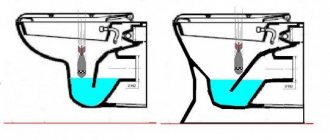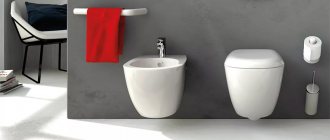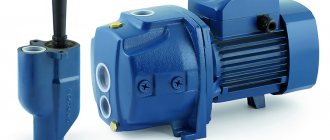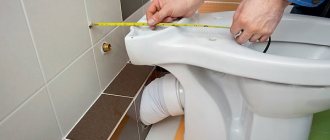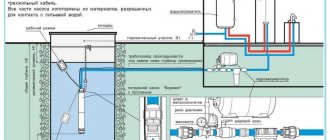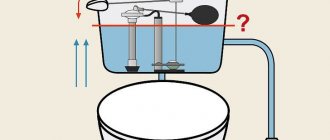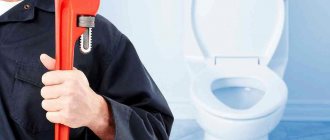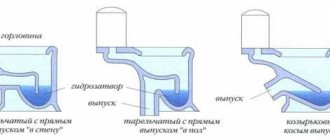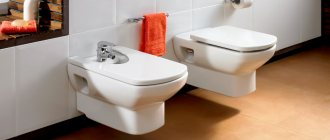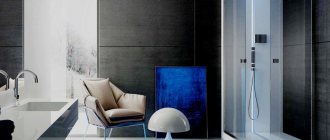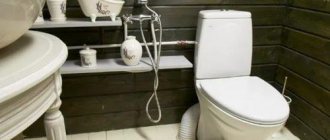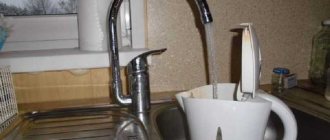Determining the purchase budget
The cost of a toilet varies depending on its type, the type of bowl, the material from which it is made, some specific parts in a particular design, but the tendency is that the total cost of plumbing is determined depending on the country of the manufacturer. For example, a ceramic toilet will cost differently in different countries. Pricing is influenced by customs duties, the technological and raw material resources of a particular country and, of course, the quality of the product.
Conventionally, the toilets on sale can be divided into three price classes:
- A budget option;
- Mid-price segment plumbing;
- Expensive luxury plumbing fixtures.
A budget option
Almost 80% of domestic products produced on an industrial scale can be classified as budget toilets. It cannot be said unequivocally that all Russian-made toilets are of low quality. No, the low cost is mainly due to the absence of duties and transportation costs. In general, the quality of domestic products is quite tolerable, and if we are talking about a foreign company that has a production branch in our country, then in this case, it is sometimes possible to buy a toilet of very good quality almost at our Russian prices.
Also quite often, toilets made in China are classified as budget plumbing fixtures. These guys like to make products of average quality, but they don’t raise the price too much. If we are talking about installing a toilet in an office, medical or educational institution, then buying budget plumbing will be the best option.
Mid-price plumbing
Plumbing fixtures in the mid-price segment are represented on the Russian market mainly by manufacturers from countries such as Finland, the Czech Republic or Poland. A very small share of toilets at average market prices is imported from Turkey and Spain. As a rule, the cost of toilets imported from these countries varies between 150-250 US dollars. However, among Spanish products you can sometimes find toilet models whose price can exceed $400.
Expensive luxury plumbing fixtures
Toilets, which can rightfully be called elite luxury plumbing fixtures, are imported into our country mainly from Germany, Austria and Sweden. These countries have long established themselves as producers of high-quality plumbing fixtures. On average, the price of a toilet, for example, from Germany ranges from $300-550. Of course, a lot still depends on which toilet company you choose, because, as you know, there are differences between companies.
Features of choosing the right toilet
It is difficult to say which toilet flush is better, since each person has his own selection criteria. A certain option will be suitable and optimal for one person, but not at all acceptable for another.
That is why it is important to choose a specific plumbing fixture in relation to all the parameters it has. In this case, you can count on the fact that you will receive a product that is ideal for future owners, and it will actually be pleasant and easy to use.
Deciding on the method of attaching the toilet
Since we are mainly talking about how to choose a toilet for your home, then, in fact, the plumbing itself should be chosen based on the layout possibilities and area of the bathroom.
The most common toilet models:
- Floor-standing;
- Hanging.
Floor standing toilets are a classic
The leg, the base, mounted motionless in a certain place, smoothly transitions into an expanded bowl. Installation of the base to the screed is carried out using anchor bolts and clamping nuts. You can often find models on sale that come with an attached skirt that can completely cover the lower base of the toilet. This skirt successfully protects the lower base of the plumbing fixtures from premature contamination, that is, wet cleaning of the outer surface of the toilet becomes much easier.
A floor-standing toilet will fit well into a layout with a separate bathroom or, if the toilet and bath are combined and the total area of the room exceeds 6 square meters. m.
Another option for a floor-standing toilet are devices that can be installed in a corner.
Corner toilets have a special shape of the tank and the back of the bowl, which allows them to be installed in the corner of the room.
In all other cases, if the bathroom area is small, then in order to save space, it would be optimal to choose a wall-hung toilet.
Prices for floor-standing toilets:
Wall hung toilets
In wall-hung toilets there is no leg at all - a base and, moreover, when installing them, the toilet can be mounted as close as possible to the wall.
The toilet is secured to the wall plane using a metal frame integrated into the thickness of the wall, which is secured using special anchors or welding.
Prices for wall hung toilets:
In addition to floor-mounted and wall-hung toilets, it is much less common to find attached toilets on sale. An attached toilet, figuratively speaking, is a hybrid of a floor-mounted and wall-hung toilet. That is, the plumbing has a base installed on the floor surface, but the toilet itself is installed close to the back wall. In this case, the drain tank is located in the thickness of the wall. It is difficult to explain why this type of toilet is less popular. Most likely, it's just a matter of habit.
Direct release type
Direct type release has two subtypes, they differ significantly from each other:
- Output direction is horizontal;
- The exit direction is vertical.
Connection to the sewerage system via a horizontal line
In multi-storey buildings, apartment owners are faced with a horizontal view. These are houses of modern construction. It is not recommended to change the position of the sewer connection hole, even if an oblique outlet is provided. In this case, using special pipes, a connection is made in a straight line.
The model is often purchased because it allows you to install it close to the wall and add square centimeters of usable space. Plus, the connected plumbing looks neat. The connecting element is the cuff.
The choice of a model with a horizontal outlet connected to the sewer is justified by the advantages of this method:
- installation is not difficult. The work can easily be done with your own hands;
- the model after installation looks compact and attractive;
- in the event of an emergency, getting to the connection point is not difficult, which allows you to quickly figure out the cause and fix the breakdown.
When a horizontal toilet outlet is connected without meeting all the work requirements, problems will soon surface.
Suspended and floor-mounted plumbing fixtures with outlet in a horizontal plane
Such models are in demand on sale. Companies are developing floor structures, suspended and attached type products with horizontal exit. Three models with direct release remain the best-sellers today:
- Cersanit Delfi Leon toilet, country of origin – Poland. Installed in a hanging manner. For sale is a kit with a direct type outlet, installation, and a complex economy button for draining. The complete set was completed with a microlift system. The price of the set is 7.8 thousand rubles;
- design Serel SM12+SAN85, country of origin: Germany. The kit is identical to the first option. Consists of hanging type plumbing, installation, 2 flush buttons. Price – 21.8 thousand rubles;
- model Cersanit Nano 213 N011 is produced in Poland, equipped with: microlift cover, economical drain button, anti-splash. Price – 9.0 thousand rubles.
Choosing a toilet bowl
Toilet bowls come in the following shapes:
Funnel-shaped
Disc-shaped
Visors
Funnel bowl
In a funnel-shaped bowl, the drain hole is located almost in the center. As a rule, most of the sewage immediately ends up in the drain, and when the water in the drain tank is drained, the sewage remaining on the surface is completely washed away. We can safely advise buying a toilet with a funnel-shaped bowl to all those who are puzzled by the question of how to choose the right toilet without splashing, so as not to regret it later. There will be absolutely no splashes, and besides, there is practically no need to use an additional brush.
Disc bowl
The dish-shaped bowl is characterized by the fact that the drain hole is slightly shifted forward, and there is a small depression in the path of water flow from the drain fittings to the drain. During operation, all human waste products initially do not end up in the drain, but in a plate-shaped recess, from where they are subsequently washed out under the pressure of the drained water in the tank.
When installing a toilet with a disc bowl, additional adjustment of the operation of the flush tank and adjustment of the volume of water supplied for flushing is often required. The whole point is that in a disc-shaped bowl, with excess pressure, turbulence can occur in the water flow, which, in fact, can lead to splashing.
Visor bowl
In the visor toilet bowl, the sewer drain hole is also approximately forward. However, in the place where the dish-shaped bowl has a recess, the visor bowl, on the contrary, has a small protruding radius bend. During operation, most of the sewage rolls down the wall of the bowl directly into the drain, and the remaining residues are washed out by the pressure of water. Toilets with a visor bowl, as well as with a funnel bowl, very rarely splash water.
Constructions
The first person who was able to appreciate all the delights of a device with a mechanical flush cistern in the toilet was the Queen of England in 1596. However, the royal apartments did not have running water or a sewage system, so people were able to use this device only 150 years later, when the English inventor T. Twyford improved his product and gave it the very original name Unitas, meaning “unity.”
When planning to purchase a much-needed piece of plumbing, you need to know how it works.
All toilets are a structure of 3 components:
- bowls;
- cistern;
- toilet seat or, as it is more often called, seats.
The cistern contains the main elements that allow it to function:
- the release lever activates the mechanism “responsible” for flushing the toilet;
- float and valve supplying water;
- drain valve
All these components are very important, but the main one in the toilet is the bowl, or rather, its shape. Manufacturers today offer a variety of models: bowls that look like a flat plate, a funnel or a cap visor.
Experts believe that the funnel-shaped toilet bowl is the most hygienic of the above. The funnel allows you to instantly wash away all the waste products of the human body, “twisting” them into the funnel, however, splash options are present in this case.
Round plate-shaped bowls are practically not used today - they do not meet hygienic requirements.
The flatter bowl, similar to the visor of a headdress, has a lip that helps avoid splashes when flushing.
Toilet flushing systems
In modern toilet models, sewage is flushed in two ways:
- Direct flush;
- Reverse circular flush.
Direct flush
The direct flush system is characterized by the fact that water moves almost in a straight path from the drain hole of the tank along the wall of the bowl to the drain.
Due to the straight trajectory of the water flow, direct drainage is also called cascade or horizontal. In principle, this flushing system was implemented in almost all models of toilets manufactured during the Soviet era.
+ The advantage of direct drainage is that in one go, releasing a powerful stream of water, you can wash away all the impurities located in the center of the bowl.
— The disadvantage of direct drainage is that during descent the water flow does not cover or only slightly washes the inner surfaces of the bowl, as a result it is necessary to use a brush.
Circular flush
A reverse circular flush, or as it is also called a ring or shower system, is fundamentally different from the flush described above.
In a shower system, water does not flow in a straight path, but when the tank is lowered, the pressure moves along a kind of annular groove and flows evenly over the entire area of the bowl. + The advantage of the reverse circular system is that there is practically no noise and, during flushing, the entire surface of the bowl is uniformly washed.
— Disadvantages of a circular system - the plumbing in which this system is implemented is much more expensive than toilets with direct flush.
There is also a high risk that after a few years, the drain holes located in the gutter under the rim may become clogged due to salt deposits.
When wondering how to choose a toilet that flushes well, as a rule, you have to choose between “two evils.” In the first case, plumbing will cost less, but sometimes it will be necessary to resort to a brush. In the second case, the plumbing will cost more, but the toilet will always be clean and tidy.
Rimless toilets: are they worth buying?
Definitely yes, if your budget allows you to purchase a toilet without a rim, then you should make a choice in its direction. It is much easier to care for it, due to the lack of difficult-to-reach places, and in general, there are no places for the accumulation of salts and waste in such toilets, so they have no equal in terms of hygiene and aesthetics.
And if you also equip such a toilet with a modern installation system with fresh liquid from the famous Portuguese factory Oli, called Oli Pure 120, then you will also completely get rid of the accumulation of unpleasant odors and receive enthusiastic responses from your neighbors like: “Wow, why is your water in so blue in the toilet? And the toilet smells so nice! How did you achieve this result?
And so that you can personally see the benefits of rimless toilets and modern flushing systems with fresh liquid, we present to your attention several informational videos!
How to choose a splash-free toilet - anti-splash system, how to determine its presence when buying a toilet
The system is designed to compensate for splashes during toilet operation. It should be noted that the labeling of many toilets indicates the presence of such an option, but in practice you should not trust the advertising tricks of manufacturers. You can make the right choice yourself by studying how the system works and what it consists of.
Some consultants in plumbing stores try to tell the client that the anti-splash is an inclined wall on the inner surface of the device, along which water slowly flows, thereby not forming splashes. This explanation cannot be real and suggests that either the seller is illiterate or is trying to sell a product that does not have an anti-splash system.
An anti-splash in a toilet is a drain hole made in a special geometric shape, which is narrowed as much as possible and recessed into the lower part of the toilet. In addition, the hole is shifted relative to the axis of symmetry to one of the sides, and the level of the water column in the hole is significantly reduced. In addition, a circular rim is designed along its contour, which performs additional compensation functions.
The photo shows the anti-splash system in all its glory.
Taking a closer look and correcting for optical distortions caused by water in the photo, you can determine that the drain hole is very narrow and the water level is unusually low.
How to calculate the height of the water column in the drain hole while in the store
When considering a purchase option, it is necessary to determine the water level in the unconnected product, which, as you know, should be the lowest. This skill will be useful for choosing a high-quality toilet with an anti-splash system.
From the physics course we know that according to the law of communicating vessels, the level in the toilet will be determined by the lower point of the outlet, located on the back side.
To determine the water level, it is enough to mentally draw a line parallel to the floor through the bottom point of the toilet outlet channel and, based on the level of this line, determine the column of water in the drain hole.
The anti-splash criteria for any shape, size, or color of the toilet are the same. Taking them as a basis, you can be sure that the chosen toilet will meet your desires and bring only pleasure.
Connecting a toilet to a sewer with a floor outlet
The position of the structure in the floor is fixed with a special flange for connection.
Silicone sealant is used to seal seams.
The connection is carried out carefully and slowly in a strict sequence:
- The location of the model is chosen at the discretion of the owners, but ensuring that the sewer hole coincides with the toilet outlet.
- A felt-tip pen on the floor marks the place where the fasteners of the legs of the structure are fixed. This will prevent it from shifting during installation work.
- Bolts are inserted into the holes in the flange, which will fix the position of the model.
- A flange is installed in the sewer outlet. First, the place where it joins the pipe is coated with sealant to strengthen the fixation.
- The next step is very important. Particular care is taken to align the model's inlet with the flange connector built into the floor. To enhance the seal, use a rubber gasket or silicone sealant.
- The release position of the structure is secured to the flange with special fasteners.
- The position of the plumbing fixtures on the floor surface is fixed. To do this, its leg is strengthened with bolts.
- By draining water into the bowl, check that there are no leaks at the joints.
Trying to replace the flange with a rubber seal will result in the plumbing becoming unstable on the floor.
Anyone can carry out the connecting work independently.
How to determine which sewer outlet is needed?
It must be said right away that any of the indicated types of sewer outlet does not have any disadvantages or advantages. Plumbing manufacturers specially develop models with different outlets to facilitate installation and connection of the toilet to the sewer system.
That is, when going to the store to buy a new toilet, it is imperative to visually inspect the location of the sewer pipe and its socket in the bathroom. Based on the location of the socket - the entrance to the sewer pipe, a toilet with a certain type of outlet is selected.
Toilet models come with three types of sewer outlet:
Oblique release
Models with oblique outlet - installed if the socket is located either on a slope or very close to the floor surface. For example, after dismantling the old toilet, a screed was made, possibly even with a warm floor or insulation, as a result, the entrance to the sewer began to be located only a few centimeters above the floor base.
Horizontal release
Models with horizontal outlet - are purchased if the socket located on the riser is raised above the floor level in the bathroom by 5-10 cm. Or in cases where the sewer pipe is located in the thickness of the screed, and an L-shaped riser rises above the floor surface entrance socket
Vertical release
Models with vertical outlet. Since it is necessary to choose a toilet for a specific room with existing communications, there are cases when the sewerage system runs horizontally under the screed, and the socket itself is not located near the wall itself, but is pushed forward, for example, 40-60 cm. In this case, you can install a toilet with a vertical outlet in the place where the entrance to the sewer is located, and connect the horizontal outlet and the socket using a short corrugated cuff.
List of the best floor standing toilets of 2021
AM.PM Spirit with horizontal outlet
Modern design with regular geometric lines. An interesting combination of a flat surface and clear edges reveals the work of high-class craftsmen. Produced using FlashClean technology, there are no rims or any plastic, which increases hygiene up to 100% and minimizes the amount of splashes. The flush system saves 0.6 liters per use, which is more than 4,000 liters of water per year for a family of 4 people. The flush system produces no more than 17 dB - this is the quietest toilet in our selection.
Average price – 16,490 rubles.
AM.PM Spirit with horizontal outlet
Advantages:
- equipped with a seat with a microlift;
- modern design;
- easy to wash.
Flaws:
- there is a shortage in stores;
- there are complaints about the quality of the product;
- high price.
Cersanit City Clean On with horizontal outlet
Interesting design and practicality will appeal to anyone, even the most demanding user. The innovative KlinPro coating makes cleaning easier and prevents the appearance of plaque, rust and other contaminants on the surface of the product.
Average price – 11,490 rubles.
Cersanit City Clean On with horizontal outlet
Advantages:
- original appearance;
- rimless production technology;
- the seat can be easily removed;
- high-quality flushing system.
Flaws:
- requires additional strengthening;
- The anti-splash system does not work effectively;
- There is a defect in the first batches.
Jika Vega with oblique release
It stands out among competitors for its high quality production, universal appearance and ease of use. Compactness and ideal proportions will allow you to place this toilet even in the most modest-sized restroom.
The model has an ergonomic bowl shape and is equipped with a Slow Down mechanism for smoothly lowering the seat.
The reliable seat is made of duroplast and has an antibacterial coating.
Average price – 4310 rubles.
Jika Vega with oblique release
Advantages:
- stable base, does not require additional fastenings;
- quality materials;
- quiet drain system;
- optimal combination of price and quality;
- universal design.
Flaws:
- There are minor casting inaccuracies in some copies.
RedBlu Origin One with oblique release
The RedBlu brand was developed by Damixa specifically for Russia, taking into account the needs and wishes of domestic users.
The product is coated with a glazed composition that maintains whiteness and hygroscopicity. The swirl flush ensures uniform cleaning of the bowl, and the compact size allows the toilet to fit into a bathroom of any size.
Average price – 10,190 rubles.
RedBlu Origin One with oblique release
Advantages:
- ergonomic seat;
- efficient dual flush system;
- complete with seat and lid with microlift;
- There is a shelf on the lid of the barrel where it is convenient to put various small items.
Flaws:
- there are specimens with an uneven glaze coating;
- Additional stops are required during installation.
SANITA LUXE Best (with microlift) with horizontal outlet
Products of the Stroyfarfor plant. The Samara plant has been producing beautiful and high-quality sanitary ware for more than 75 years and occupies a leading position in the country in this area.
This product from the Best collection is made in a laconic Scandinavian style and will fit perfectly into any interior.
It has a protective coating, a Duroplast seat, a splash prevention system and a universal outlet.
Average price – 7,293 rubles.
SANITA LUXE Best (with microlift) with horizontal outlet
Advantages:
- excellent appearance;
- high-quality fittings;
- production material – sanitary porcelain.
Flaws:
- weak drainage system;
- casting quality.
Roca Dama Senso with horizontal outlet
In appearance, this is one of the most colorful specimens on our list. Soft curves and lines are the hallmark of the Senso series. The famous Italian master Giuseppe Giugiaro worked on the design.
Bowl with double outlet, material – sanitary porcelain. Drain tank and seat are not included.
Average price – 7,288 rubles.
Roca Dama Senso with horizontal outlet
Advantages:
- excellent appearance;
- splash suppression system;
- easy to clean;
- outstanding workmanship.
Flaws:
- complexity of installation;
- weak drainage system.
Laguraty multifunctional
A special combined model, designed taking into account the needs of residents of small apartments. Plumbing combines not only the function of a toilet and bidet, but also a sink, and, if necessary, even a shower.
This device will not only save space, but also use water more efficiently, and you won’t have to buy several devices necessary for the bathroom.
Average price – 29,850 rubles.
Laguraty multifunctional toilet
Advantages:
- multifunctional device 3 in one;
- convenient to use.
Flaws:
- complex installation;
- difficulties with repair due to the compact placement of internal mechanisms.
Santek Alcor with oblique outlet
New product from Suntek. Only environmentally friendly materials are used here, dual-mode fittings and the Anti-Splash system are used. The toilet is equipped with the most popular oblique flush in our country and a lower water supply to the tank. Thanks to its modern design it will fit into any interior.
Average price – 3,626 rubles.
Santek Alcor with oblique outlet
Advantages:
- popular drainage system;
- optimal price-quality ratio.
Flaws:
- drain requires additional adjustment;
- There are factory defects in casting and enamel.
IDDIS Mirro with horizontal outlet
Designed in such a way that the entire bowl is washed when flushed. The buttons are light, even a child can handle them. The economical and aesthetic toilet has a manufacturer's warranty of 25 years. The seat not only has a microlift, but is also easily removable, which makes cleaning easier. The highlight of the design is the cistern narrowed towards the top.
Average price – 9840 rub.
IDDIS Mirro with horizontal outlet
Advantages:
- compactness;
- economical flushing;
- original design;
- reliability.
Flaws:
- not identified.
Santeri West Standard with oblique outlet
The main advantages of this model are the ergonomic shape of the bowl, strong but quiet flushing and convenient installation. The toilet is made of sanitary porcelain, it looks neat, its vibrant color and compact size will allow it to take up space in any combined or separate bathroom.
The smooth surface does not accumulate unpleasant swings and is easy to clean.
Average price – 3,500 rubles.
Santeri West Standard with oblique outlet
Advantages:
- compact dimensions;
- affordable price;
- nice appearance.
Flaws:
- requires additional sealing;
- There are specimens with poorly regulated flushing.
Della Otti with oblique release
This option uses a single-mode drain with a stop function, cascade drain and anti-splash. The wear-resistant surface will ensure ease of cleaning and excellent appearance throughout the entire service life. The reliable design and laconic appearance will appeal to practical owners.
Average price – 5,450 rubles.
Della Otti with oblique release
Advantages:
- the coating does not retain dirt and rust;
- economical water consumption;
- The kit includes everything you need for installation.
Flaws:
- there are no grooves on the tank lid;
- Not the whole bowl is washed.
VitrA with horizontal outlet
Rimless toilet with microlift from a Turkish manufacturer. The unique, innovative toilet system prevents the spread of germs and ensures maximum hygiene and ease of cleaning. The flush flow divider is designed in such a way that the entire bowl is washed completely without splashing, and removable elements make the cleaning process more convenient.
Average price – 17,330 rubles.
VitrA with horizontal outlet
Advantages:
- appearance;
- easy to clean;
- excellent ergonomics;
- quiet flush.
Flaws:
- heavy - you will need help to lift it to the floor;
- Additional fastening is required during installation.
Oskol ceramics Elissa (white) with oblique release
Covered with a chemical and thermal resistant glaze. All models of the manufacturer have a perforated circular flush.
Rounded shapes and an assortment of colors add to the popularity of the product on the Russian market.
Production is located in the Belgorod region, includes the use of modern foreign technologies, high-quality domestic raw materials and extensive production experience.
Average price – 4,980 rubles.
Oskol ceramics Elissa (white) with oblique release
Advantages:
- choice of colors;
- comfortable shape;
- easy to repair;
- splash suppression system.
Flaws:
- poor drain efficiency.
Gustavsberg Artik with horizontal outlet
The product is made of high-quality porcelain, therefore it has such characteristics as durability, wear resistance, and attractive appearance. The classic oval shape and white color will suit most restroom designs.
The name Gustavsberg has been known in the world of porcelain for almost 200 years. This is a clear leader among European manufacturers in this area.
Average price – 20,050 rubles.
Gustavsberg Artik with horizontal outlet
Advantages:
- appearance;
- comfort during use;
- reliability.
Flaws:
- Additional adjustment of the mechanisms by a qualified technician may be required.
Bravat with horizontal outlet
Made from high quality sanitary ware. Covered with high-quality glaze, does not absorb odors, and retains color and shine for a long time. The lid and seat are made of durable material that does not scratch and is easy to clean. Equipped with a microlift and stainless steel hinges.
Average price – 9,841 rubles.
Bravat with horizontal outlet
Advantages:
- rich and attractive appearance;
- ease of installation
- microlift included;
- good flush.
Flaws:
- requires additional sealing;
- noisy drain.
Methods for attaching the cistern
The flush cistern connected to the toilet can be joint - mounted on the back shelf of the plumbing fixtures, or separate - located separately from the toilet on the plane of the wall or installed directly into the thickness of the wall.
The joint method of attaching the tank is a classic option, when all the plumbing is a single unit. Installing such a tank is simpler, easier and cheaper. Installation of the tank on the rear shelf of the toilet is carried out using two bronze or stainless steel bolts using rubber sealing gaskets.
This method of fastening is good because, if necessary, the drain tank can be quickly replaced with a new one due to simple installation.
A separate cistern is a good solution for bathrooms with a small area. If you purchase a toilet without a back shelf, for example, wall-hung or attached, then the toilet itself, located close to the wall, will take up less usable space.
The tank itself can be placed on the surface of the wall right under the ceiling, or additional concrete cutting can be done and the tank can be installed in the rear load-bearing wall (or a false wall can be built). It must be said that if you mount the drain tank on the wall, you can get another advantage - more powerful water pressure in the bowl. This can both save water and improve the hygiene of the toilet.
To attach such a toilet and its tank, an installation is used, which is fixed in the wall.
Models of tanks and bowls
These are the main components of each toilet. Toilet bowls usually vary in shape and are:
- disc-shaped;
- funnel-shaped;
- visor.
The plate bowl is a classic option that has been used in toilet design for quite a long time. The open shape of such a toilet does not prevent the spread of unpleasant toilet odors, so plate models are chosen extremely rarely.
Different shapes of the toilet bowl allow you to choose comfort according to the different requirements of people
Models with visor bowls, which cope with the problem of unwanted aroma much more effectively, are more in demand. Another advantage of this model is the smooth drainage of water directed at a slight angle.
Funnel-shaped bowls demonstrate high flushing efficiency because the contents of the toilet bowl move down the drain extremely quickly. However, sudden movement of water usually results in splashing, which is not very helpful in keeping the toilet clean.
The model of the tank and the type of its mounting (to the wall, inside the wall, under the ceiling, directly to the toilet) is determined by the type of toilet that has already been selected. The most reliable installation option is considered to be one in which the toilet bowl serves as the base for the tank. You can pay attention to the direction of water supply from the tank. Usually water enters from the side or from below.
The design features of the tank affect the quality of its operation. The current indicator is the amount of noise that the tank makes as it fills
Unfortunately, it has not yet been possible to invent a toilet with a silent flush, although experts continue to work in this direction. But today it is quite possible to purchase a toilet that fills almost silently.
In such models, water does not enter the tank from top to bottom, but in the form of a small fountain or through a special hose. As a result, the amount of noise coming from the toilet is much less than with traditional cistern models. Silent tanks are confidently displacing their noisier counterparts from the market.
The design of the cistern fittings should be studied as carefully as possible. Here are a few signs of a truly high-quality drain mechanism:
- the most simple design;
- the ability to purchase individual elements of the device necessary for replacement or repair;
- a valve with a float fixed at the top of the tank;
- ease of operation and maintenance.
If the mechanism is installed in a small tank and has ultra-compact dimensions, it will be difficult to repair or clean. Complex structures usually break more often, so you should choose a simple and convenient model.
If the flush mechanism parts are small and too close together, they will be more difficult to maintain.
The next important point is the design of the flush control. In “retro” type models there are no options - you need to pull a string or chain. Other models may have buttons that you press or levers that you move up. The first option is preferable because it is considered more resistant to loads and breaks less often than a lever.
Typically, the volume of a toilet bowl is 6-8 liters. This amount of water is lost with each flush. In order to save money, almost all modern tanks are equipped with a control system that allows not only complete emptying of the tank, but also the so-called “small flush”.
In this case, only part of the contents of the tank, approximately 2-4 liters, is used to flush away the sewage. Using an economical tank model can significantly reduce water consumption and sewerage maintenance costs.
Deciding on the material of manufacture
On the windows of plumbing stores you can find toilets made of the following materials:
- Faience;
- Porcelain;
- Steel;
- Cast iron;
- Decorative rock;
- Plastic.
Let's consider the main nuances of each specified material.
Earthenware toilets
Toilets made from earthenware are the cheapest and most popular. Faience is a type of white ceramic with a finely porous structure. To reduce the hygroscopicity of the material, that is, so that the porous material does not absorb moisture much, the surface of the earthenware is covered with special enamel. The color of the enamel can be white, beige, turquoise, yellowish - this does not affect the technical performance.
The disadvantage of earthenware toilets is that during many years of use, the protective glazed enamel can wear away under certain mechanical stress. When the enamel wears away, moisture begins to be abundantly absorbed into the finely porous structure of the earthenware, which leads to a general decrease in the strength of the plumbing fixtures. Simply put, the toilet can burst under the weight of an obese person. However, you shouldn’t be scared right away; a toilet made of earthenware can honestly serve its 10-15 years.
Porcelain toilets
Porcelain, used for the manufacture of sanitary ware, as well as earthenware, is made from white types of clay. However, in the production process, additional quartz and feldspar are introduced into white clay varieties, which, under the influence of a certain temperature, makes it possible to obtain a material that is less porous and more durable than earthenware. Porcelain toilets are also coated with enamel glaze, but its abrasion occurs much more slowly.
If, during many years of use, the enamel has been slightly worn out, as a rule, due to the high strength and low hygroscopicity of porcelain, this does not lead to destruction of the plumbing fixtures. The price of porcelain toilets is on average 30-50% higher than the cost of faience plumbing. Approximate service life is 20-25 years.
Steel toilets
The material used for the manufacture of this plumbing fixture is stainless steel, which is a priori incapable of absorbing moisture and to the smooth surface of which various impurities practically do not stick. Another advantage of steel toilets is their high strength. One might even say - anti-vandal strength, which makes the use of steel toilets very popular in public, crowded places. The warranty period is practically unlimited, but the price for this hygiene item is usually higher than the cost of even porcelain toilets.
Cast iron toilets
Cast iron toilets are relatively rare in the assortment of plumbing stores. This is explained by their low popularity. They are heavy, bulky and have a relatively short service life. Although cast iron is protected from rust and corrosion by enamel applied to its surface, cast iron is still a brittle metal. Typically, these toilets are used in public places with a small number of people.
Marble and artificial stone
Toilets made from decorative varieties of marble or artificial stone are an excellent solution for true connoisseurs of interior styles such as Baroque, Empire or Classicism. Of course, this piece of sanitary ware is more expensive than all the types described above, but in addition to the unique design and finish, marble toilets have such a positive quality as increased hygiene.
The bottom line is that the surface of marble is polished in a factory to such an extent that its smoothness can only be compared with glass. It is enough to use even the weakest pressure of water to drain to wash away all impurities almost down to the smallest particles.
Plastic toilets
Plastic toilets are mainly made from acrylic. There are models in which there is a multi-layer, fiberglass-reinforced structure. They are distinguished by their low dead weight, simple installation and low cost. Disadvantages include the low strength of the product, susceptibility to temperature changes and a relatively short service life. People often prefer to buy a toilet made of plastic for installing it in the country.
What material should the toilet be made of?
The material from which the sanitary ware is made is one of the most important points in the difficult task of completing a bathroom. Most often, when deciding which material to choose a toilet from, buyers choose between sanitary ware and porcelain. These are the two most common materials that are used very widely in the manufacture of plumbing fixtures.
They differ mainly in one indicator - porosity, which is higher in sanitary ware. This means that such products absorb dirt better and are therefore more difficult to clean. Porcelain is less porous, more durable and more expensive.
A standard sanitary ware toilet can last about 30-40 years, but the service life of porcelain products can be 60 years. However, plumbing manufacturers are already concerned with developing sanitary ware with reduced porosity, which increases its service life.
Atypical materials include inexpensive stainless steel, pretentious options made of gold or silver, copper or bronze, as well as stone models. Stainless steel products are an inexpensive and relevant choice for public toilets.
A toilet made of artificial stone is an excellent choice for creating an exclusive design in the bathroom. These models are usually made or delivered to special order.
A toilet made of natural stone is rather a work of plumbing art, which is not very convenient to use for its intended purpose. A more practical choice would be a toilet made of artificial stone: it looks almost the same as a natural one, costs less, and is more convenient to use.
The insertion of artificial material under natural stone adds sophistication to the interior, especially if the tone of the insert is matched to the overall color scheme of the bathroom
Models made from non-traditional materials are rarely found on the market; they are usually made to special order.
If it is not possible to purchase a designer toilet model, you can diversify the interior of the bathroom with the help of a beautiful lid or an original sticker on the tank
Gesso W101
Photo: https://beru.ru
The Gesso W101 compact toilet from a Russian manufacturer has an oblique single outlet. There are 2 holes in the base - one on each side. They are necessary for rigid installation of the entire structure to the floor covering. In addition to the bowl and tank, the kit also includes a toilet seat, the necessary fittings and mounting bolts. This toilet model is characterized by a highly durable body and ease of installation. If you don’t know which toilet flushes better, then take a closer look at the Gesso W101.
Gesso W101
Advantages:
- price
- design
- compact
- washes off well
- quality
- anti-burst
Flaws:
- single flush button
- bad instructions
Cersanit Nature Clean On KO-NTR011-3/5-COn-DL-w
Photo: https://beru.ru
Cersanit Nature Clean On is a rimless, floor-standing compact toilet that has an antibacterial seat with a soft-closing function and an easily removable mechanism. This model has two-level fittings with a 3/5 l flush mechanism. The toilet seat is made of duroplast.
Cersanit Nature Clean On KO-NTR011-3/5-COn-DL-w
Advantages:
- price
- design
- compact
- high-quality assembly
- washes off well
- seat with microlift
Flaws:
- bad fittings included
- bad anti-splash system
Ideal STANDARD Connect E781701
Photo: https://beru.ru/
Ideal Standard Connect E781701 - toilet with bidet function. The design provides for one of the simplest and most reliable installation methods - floor-mounted. This model is equipped with the most universal, horizontal exhaust system, which allows it to be mounted either close to or at a short distance from the wall. The flush cistern is mounted on top of the toilet, thereby saving centimeters of space. The drainage mechanism has two buttons that allow full or half drainage to save water.
Ideal STANDARD Connect E781701
Advantages:
- anti-dirt coating
- good drain
- anti-burst
- price
Flaws:
- no installation included
- no tank included
- no seat included
Division of toilets by cost
Several factors influence the cost of a toilet. These include the type of product, the shape of the bowl, the material of manufacture, the presence or absence of certain elements, direct or oblique toilet outlet. However, the country and the manufacturer directly have a greater influence on price formation. Here, the pricing policy depends on the use of innovative technologies and the quality of raw materials, as well as customs duties.
In general, all toilets are presented in three options, which you need to know about before choosing a good toilet for your home. In particular, we are talking about the following:
- Budget products.
- Medium price class equipment.
- Luxury plumbing.
The budget option can be called the bulk of toilets produced in Russia at the industrial level. However, when deciding which toilet is best to choose for your home, you should not conclude that all products are of low quality. In this case, the absence of customs duties and insignificant transport costs are taken into account. As for imported products, they can also be purchased at an affordable price, provided that the manufacturer has a branch in Russia.
To answer the question of how to choose the right toilet for an apartment, it is important to understand that products made in China can also be classified as a budget option. These products are characterized by average quality at a very affordable price. In general, we can conclude that for public spaces of average traffic, the budget option is the optimal solution.
Toilets, which are characterized by an average price, are mainly produced in Finland, the Czech Republic and Poland. And only a small number of products can be found made in Turkey or Spain. This must be taken into account when solving the problem of how to choose a toilet, which manufacturer is better.
Toilets belonging to the elite class and sold in Russia are represented by models from German, Austrian and Swedish manufacturers. It is in these countries that the highest quality sanitary equipment is produced.
